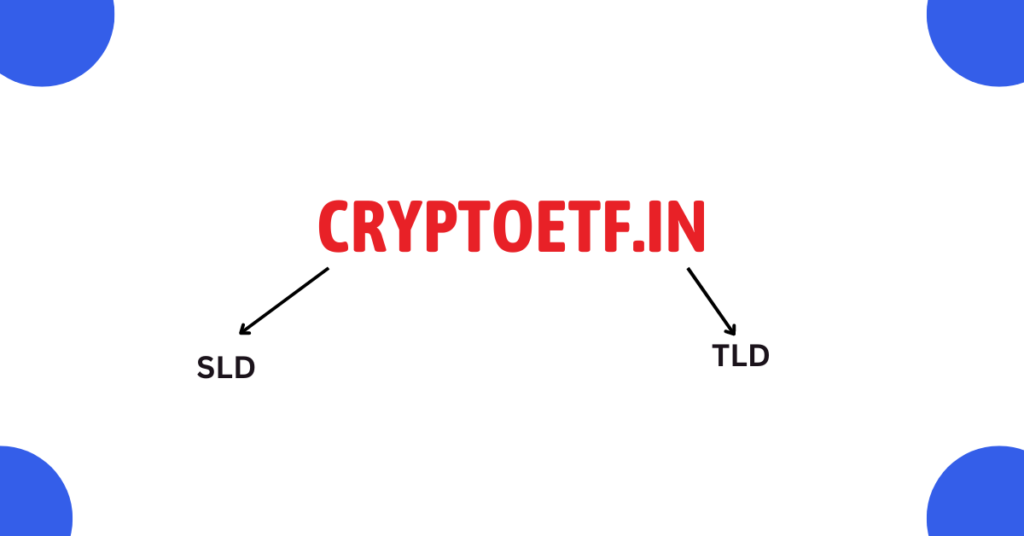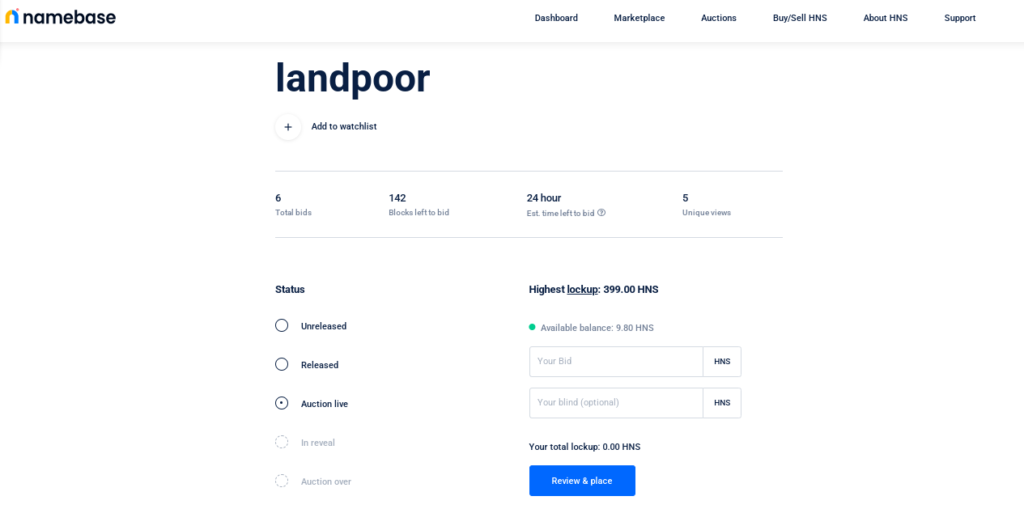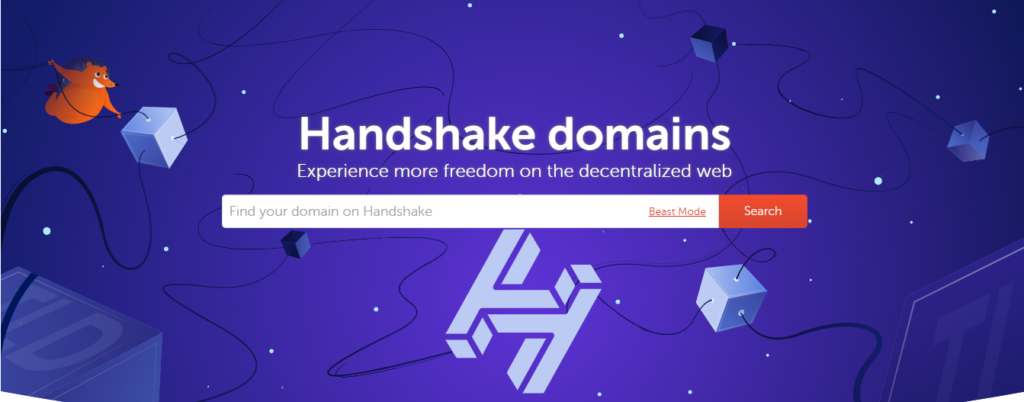In the rapidly evolving realm of blockchain technology, Handshake (HNS) domains have emerged as a groundbreaking idea, fundamentally changing how we view and engage with the internet. In this extensive guide, we will thoroughly explore the universe of Handshake domains, delving into their complexities, capabilities, and the significant influence they are poised to have on internet ownership. By the conclusion of this article, you will have a deep understanding of Handshake domains and the reasons they are positioned to revolutionize the digital landscape.
What is a handshake (HNS) domain?
Handshake (HNS) is a decentralized and permissionless naming protocol that enables peer-to-peer communication and offers a viable alternative to the centralized management of domain names, including traditional ones like .com, country-code domains, and other generic domains.
In its role as a decentralized peer-to-peer domain naming system, Handshake seeks to provide an alternative to the conventional root chain used in the Domain Name System (DNS). Currently, the creation of top-level domains (TLDs), such as .agency, .gov, .edu, etc., is overseen by the Internet Corporation for Assigned Names and Numbers (ICANN), involving a complex application process.
Under the existing system, individuals or organizations looking to introduce a new TLD must navigate a cumbersome process that includes applying for the TLD, participating in auctions to secure it, and awaiting approval. This process is not only intricate and costly but is also highly centralized, rendering it susceptible to hacking, corruption, and censorship vulnerabilities.
Handshake’s vision is to revolutionize this system by offering alternative top-level domains that are more efficient, cost-effective, and secure. Through blockchain technology, Handshake aims to circumvent the current ICANN-controlled framework, contributing to the development of a more decentralized online domain landscape.
Handshake vs traditional
Handshake (HNS) and traditional DNS (Domain Name System) are both systems for managing domain names and mapping them to IP addresses, but they operate differently and have distinct goals and features.
Traditional DNS:
- Centralization: Traditional DNS is highly centralized and relies on a hierarchical structure managed by organizations like ICANN (Internet Corporation for Assigned Names and Numbers). The root zone file is controlled by a small number of authorities.
- Resolution Chain: When you enter a domain name in your browser, traditional DNS uses a series of DNS resolvers to look up the IP address associated with that domain. These resolvers query authoritative DNS servers until they find the correct IP address.
- TLDs: Traditional DNS includes well-known top-level domains (TLDs) like .com, .org, and .net, which are managed by central authorities.
Handshake (HNS):
- Decentralization: Handshake aims to create a decentralized alternative to traditional DNS. It replaces the reliance on central authorities with a blockchain-based system.
- Root Zone: Handshake has its own root zone, separate from the traditional DNS root zone. To resolve HNS domains, you need a Handshake-aware resolver, which operates on a peer-to-peer network rather than relying on centralized servers.
- Compatibility: Handshake doesn’t seek to replace traditional DNS entirely. Instead, it coexists with it. The goal is not to disrupt existing TLDs but to introduce a parallel system. Existing TLDs can also claim their equivalent HNS domain if they choose to participate.
- Reserved TLDs: Handshake has reserved TLDs to ensure compatibility with existing TLDs. Managing organizations have the option to claim these reserved TLDs over a specific time frame.
In summary, Handshake is designed to introduce a decentralized alternative to traditional DNS, allowing users to create and manage domain names without relying on centralized authorities. However, it doesn’t seek to replace the existing DNS infrastructure entirely, and compatibility measures have been put in place to ensure a smooth transition for those who choose to participate in the Handshake ecosystem.
| Aspect | Traditional DNS | Handshake |
|---|---|---|
| Ownership | Leasing only | Full ownership |
| Fees | Annual leasing | One-time purchase |
| Domain Type | Only second-level domains from a limited set of TLDs (e.g., .com, .net, .in) | Unlimited TLDs, including foreign characters and emojis |
| Security | Low | High |
| Privacy | Low | High |
| Censorship | Easily censorable and/or seized | Censorship and tamper-resistant |
This table provides a clear comparison of key attributes between Traditional DNS and
Top-level domain vs Second-level domain

| Domain Level | Description | Example |
|---|---|---|
| Top-level Domain (TLD) | The highest level in the domain hierarchy, often indicating the purpose or geographical location of a website or organization. | .com, .org, .net, .gov, .uk, .ca |
| Second-level Domain (SLD) | The level immediately below the TLD, representing a specific entity, brand, or website within the broader TLD category. | example.com, wikipedia.org, google.co.uk, amazon.ca |
This table provides a brief explanation of TLDs and SLDs and includes examples for better understanding.
How do I get a handshake top-level domain?

Handshake operates by distributing website addresses through automated auctions conducted by Handshake’s software. These TLD (Top-Level Domain) auctions occur every two weeks, and participants must bid using Handshake’s cryptocurrency, HNS (Handshake Network System), to take part.
In these auctions, the winning bidder pays the second-highest price, employing a Vickrey auction format. In a Vickrey auction, bidders submit sealed bids without knowledge of others’ bids. This approach ensures fairness and efficient allocation of domain names at their true market value.
The Handshake blockchain operates in a manner similar to the Bitcoin (BTC) blockchain. Miners run Handshake software and compete to unlock newly created HNS tokens by solving mathematical puzzles. Every 10 minutes, new blocks are added to the Handshake blockchain, and miners are rewarded with 2,000 HNS for every 10 minutes of mining. The total supply of HNS is capped at 2.04 billion.
How do I get a handshake second-level domain?

It appears that Namecheap has simplified the process of registering a Handshake second-level domain (SLD) by integrating it into their platform and making it similar to registering a traditional DNS domain. Here are the steps to register a Handshake SLD on Namecheap:
- Search for an Available Handshake SLD:
- Go to the Namecheap website and use their search bar to look for an available Handshake SLD. Enter the name you desire, and Namecheap will display the available Handshake domain extensions.
- Select and Add to Shopping Cart:
- Choose the Handshake SLD you want from the list of available options. Click on it to add it to your Shopping Cart.
- Proceed to Checkout:
- Once you have added the Handshake SLD to your cart, click on the “Checkout” button when you’re ready to complete the purchase.
- Log In or Create an Account:
- If you already have a Namecheap account, log in. If not, you’ll need to create one during the checkout process.
- Configure Your Domain:
- After completing the purchase, you can log in to your Namecheap account to configure your Handshake SLD. This typically involves setting up DNS records, linking it to a website or service, or customizing its functionality as needed.
Other Sld seller
Accessing Handshake Domains
One thing to note is that Handshake domains don’t work in regular web browsers. To access them, you’ll need special tools.
Through Browser Extensions
Several browser extensions enable Handshake domain access. It’s like adding a secret tunnel to the virtual city.
Fingertip
Fingertip is a dedicated tool for Handshake domain access. It’s like having a master key to the city’s gates.
HDNS.io
HDNS.io is another user-friendly way to explore Handshake domains. It’s like having a detailed map of the virtual world.
HNS.to
HNS.to simplifies Handshake domain access. It’s like having an express route to your destination.
NextDNS
NextDNS offers DNS resolution for Handshake domains. It’s like having a reliable GPS for the digital highways.
VPNs
Some VPN services support Handshake domain access, ensuring your online privacy. It’s like wearing an invisibility cloak in the virtual city.
Pros and Cons of Handshake Domains
Advantages
- Enhanced Privacy and Control: Handshake domains give you greater privacy and control over your online presence, like having your own private island in the digital ocean.
- Flexibility in Domain Usage: Use Handshake domains in multiple creative ways, from hosting websites to creating subdomains, like having a versatile toolbox.
- Participation in Domain Auctions: Join domain name auctions and potentially find valuable virtual properties, like becoming a virtual real estate mogul.
Disadvantages
- HNS Coin Requirement: To participate in auctions or use Handshake services, you need HNS coins, which can be a barrier for those new to cryptocurrency.
- Complexity for Beginners: Setting up and using alternative domains like Handshake can be more complex for newcomers, like learning a new language.
The Future of Handshake Domains
The internet is evolving, and Handshake domains are part of this evolution. They aim to simplify online addresses and promote user-friendly web navigation. However, questions remain.
Will Handshake domains become accessible to everyone, or will they remain a digital frontier for the tech-savvy? What happens if traditional domain organizations like ICANN release conflicting TLDs? Will Handshake become the next major player in domain names?
Only time will tell if Handshake domains will rise to prominence or fade into the background of the ever-changing internet landscape.
What is a Handshake Domain Used For?
In the vast landscape of the internet, Handshake domains are like the keys to a hidden treasure chest. They open doors to a world of possibilities that can benefit individuals and businesses alike. Let’s delve into what Handshake domains are used for and how they can revolutionize your online presence.
The Versatile Nature of Handshake Domains
Handshake domains, at their core, function much like traditional domain names. They serve as your online address, directing users to your website or online service. However, what sets Handshake domains apart is their versatility. Here are some exciting use cases:
1. Sell Subdomains
Imagine owning a piece of virtual real estate and renting out subdomains to others. Handshake domains allow you to do just that. You can create subdomains, extending your domain name and even make a profit from it. It’s like having your own online property empire.
2. Log In Securely
Tired of juggling a myriad of passwords? Handshake provides a secure and private login method that doesn’t require remembering a plethora of login credentials. It’s akin to having a digital key that unlocks your online world securely.
3. Redirects and URL Shortening
Long and cumbersome web addresses can be a hassle. Handshake domains can be used as URL shorteners, simplifying web links for easy sharing. It’s like having a shortcut to your favorite online destinations.
4. Create a Decentralized Hub
With dLinks, Handshake domains enable you to build a decentralized hub for your online content. Think of it as your personal library in the digital realm, accessible to anyone interested in what you have to offer.
5. Your Unique Email Address
Your Handshake domain can host your email address, giving you a unique and personalized email identity. It’s like having your own mailbox in the vast landscape of the internet.
6. Build Websites
Using dWord, you can build and host websites on your Handshake domain. It’s like owning a piece of virtual real estate where you can showcase your ideas, products, or services to the world.
7. Nomad: Your Social Networking Username
No more settling for complex usernames on social networking sites. Handshake names can serve as your username, making it easier for others to find and connect with you. It’s like having your name as your online badge.
8. Creating a Website
Creating a website on Handshake is a breeze, thanks to platforms like Sia Skynet, GitHub Pages, Heroku, Vercel, or WordPress. It’s like setting up your digital storefront in the heart of the internet.
Learning Resources
Conclusion
In a world where online identities matter, Handshake domains offer a glimpse into the future of the internet. They provide control, privacy, and versatility in the digital realm. Whether you’re an entrepreneur, a content creator, or just someone looking for a unique online presence, Handshake domains have something to offer.
So, as you navigate the virtual city of the internet, remember that Handshake domains are the exciting new neighborhoods worth exploring. Get ready to claim your digital space, one Handshake at a time!

Naren is a finance graduate who is passionate about cryptocurrency and blockchain technology. He demonstrates his expertise in these subjects by writing for cryptoetf.in. Thanks to his finance background, he is able to write effectively about cryptocurrency.
